fuel TOYOTA IQ 2012 Owner's Manual
[x] Cancel search | Manufacturer: TOYOTA, Model Year: 2012, Model line: IQ, Model: TOYOTA IQ 2012Pages: 476, PDF Size: 23.52 MB
Page 229 of 476
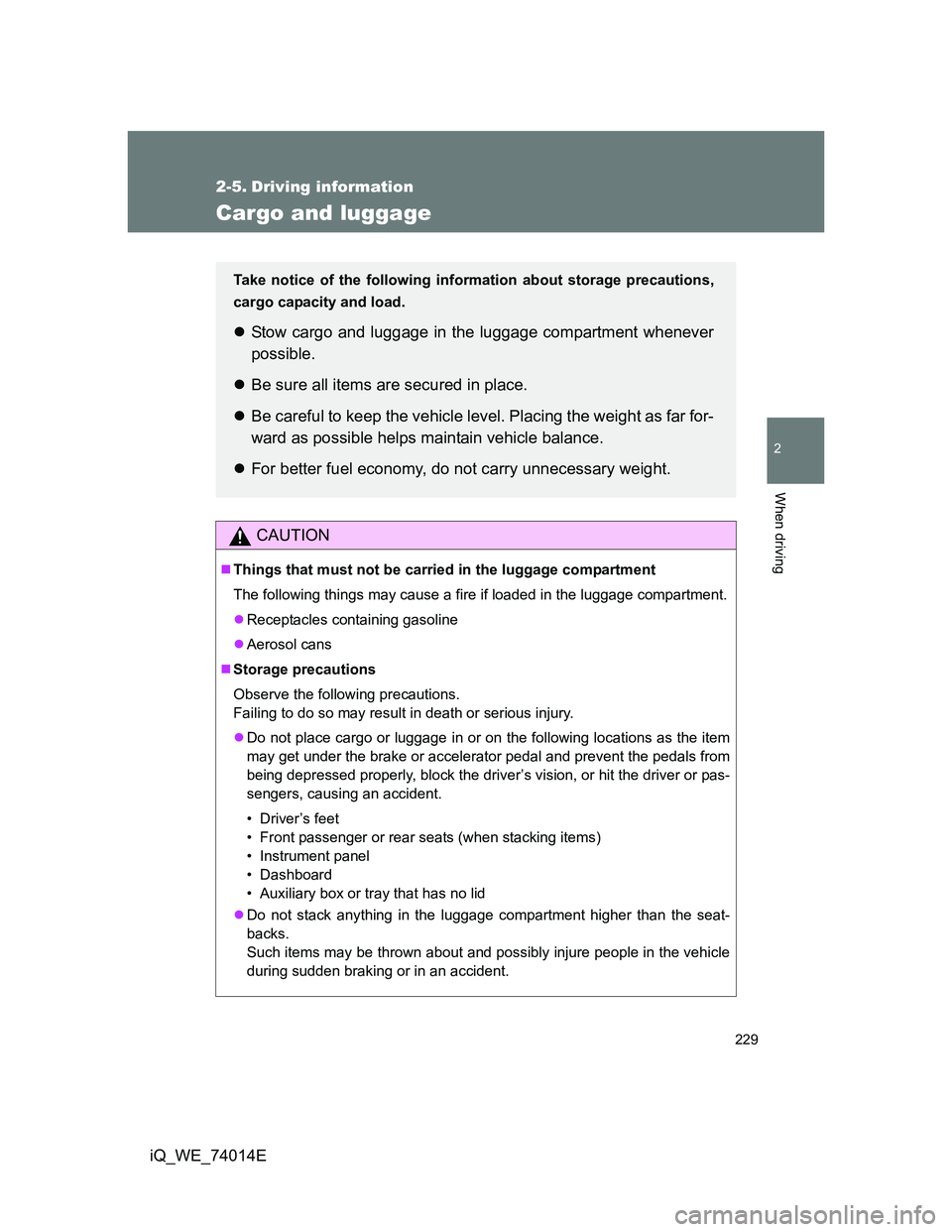
229
2
When driving
iQ_WE_74014E
2-5. Driving information
Cargo and luggage
CAUTION
Things that must not be carried in the luggage compartment
The following things may cause a fire if loaded in the luggage compartment.
Receptacles containing gasoline
Aerosol cans
Storage precautions
Observe the following precautions.
Failing to do so may result in death or serious injury.
Do not place cargo or luggage in or on the following locations as the item
may get under the brake or accelerator pedal and prevent the pedals from
being depressed properly, block the driver’s vision, or hit the driver or pas-
sengers, causing an accident.
• Driver’s feet
• Front passenger or rear seats (when stacking items)
• Instrument panel
• Dashboard
• Auxiliary box or tray that has no lid
Do not stack anything in the luggage compartment higher than the seat-
backs.
Such items may be thrown about and possibly injure people in the vehicle
during sudden braking or in an accident.
Take notice of the following information about storage precautions,
cargo capacity and load.
Stow cargo and luggage in the luggage compartment whenever
possible.
Be sure all items are secured in place.
Be careful to keep the vehicle level. Placing the weight as far for-
ward as possible helps maintain vehicle balance.
For better fuel economy, do not carry unnecessary weight.
Page 306 of 476
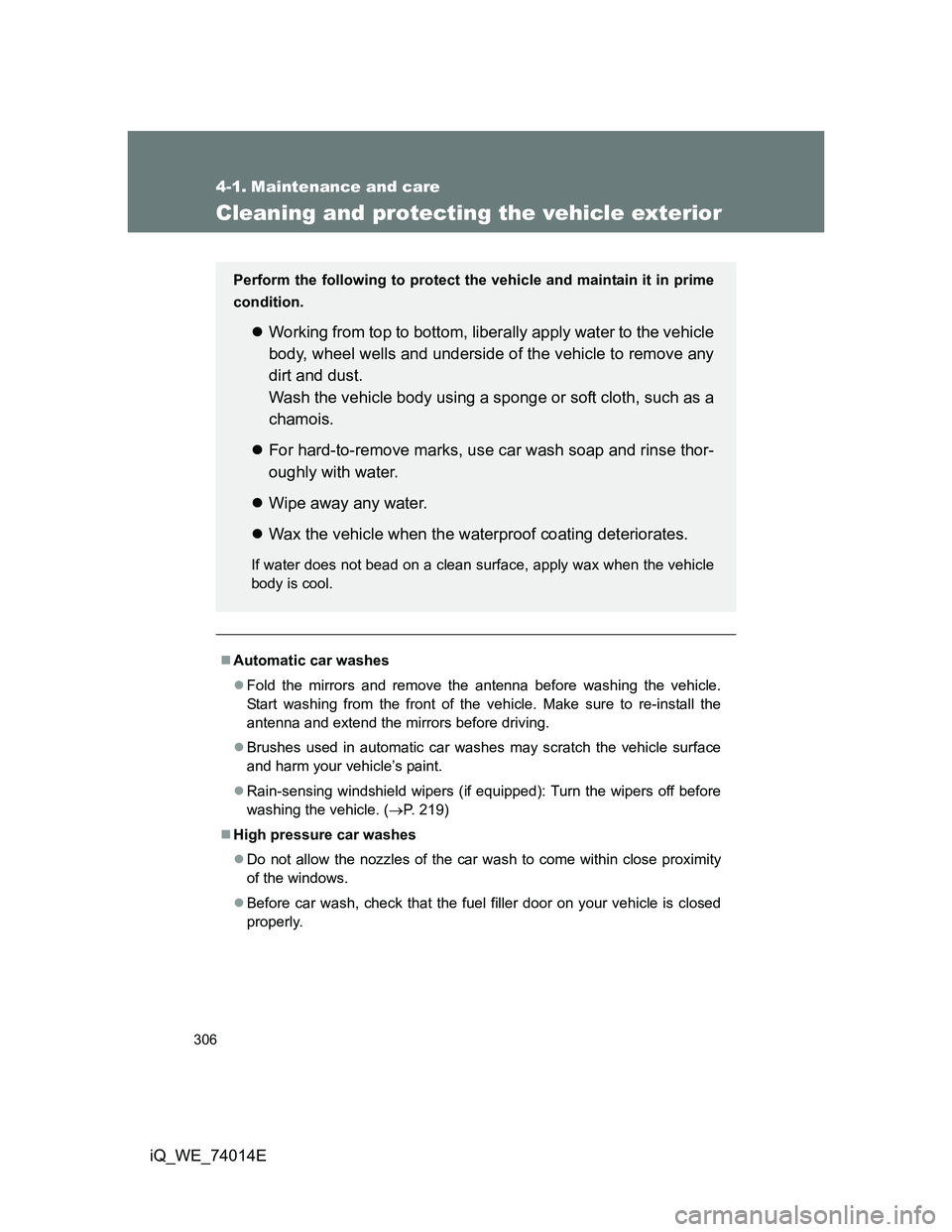
306
iQ_WE_74014E
4-1. Maintenance and care
Cleaning and protecting the vehicle exterior
Automatic car washes
Fold the mirrors and remove the antenna before washing the vehicle.
Start washing from the front of the vehicle. Make sure to re-install the
antenna and extend the mirrors before driving.
Brushes used in automatic car washes may scratch the vehicle surface
and harm your vehicle’s paint.
Rain-sensing windshield wipers (if equipped): Turn the wipers off before
washing the vehicle. (P. 219)
High pressure car washes
Do not allow the nozzles of the car wash to come within close proximity
of the windows.
Before car wash, check that the fuel filler door on your vehicle is closed
properly.
Perform the following to protect the vehicle and maintain it in prime
condition.
Working from top to bottom, liberally apply water to the vehicle
body, wheel wells and underside of the vehicle to remove any
dirt and dust.
Wash the vehicle body using a sponge or soft cloth, such as a
chamois.
For hard-to-remove marks, use car wash soap and rinse thor-
oughly with water.
Wipe away any water.
Wax the vehicle when the waterproof coating deteriorates.
If water does not bead on a clean surface, apply wax when the vehicle
body is cool.
Page 317 of 476
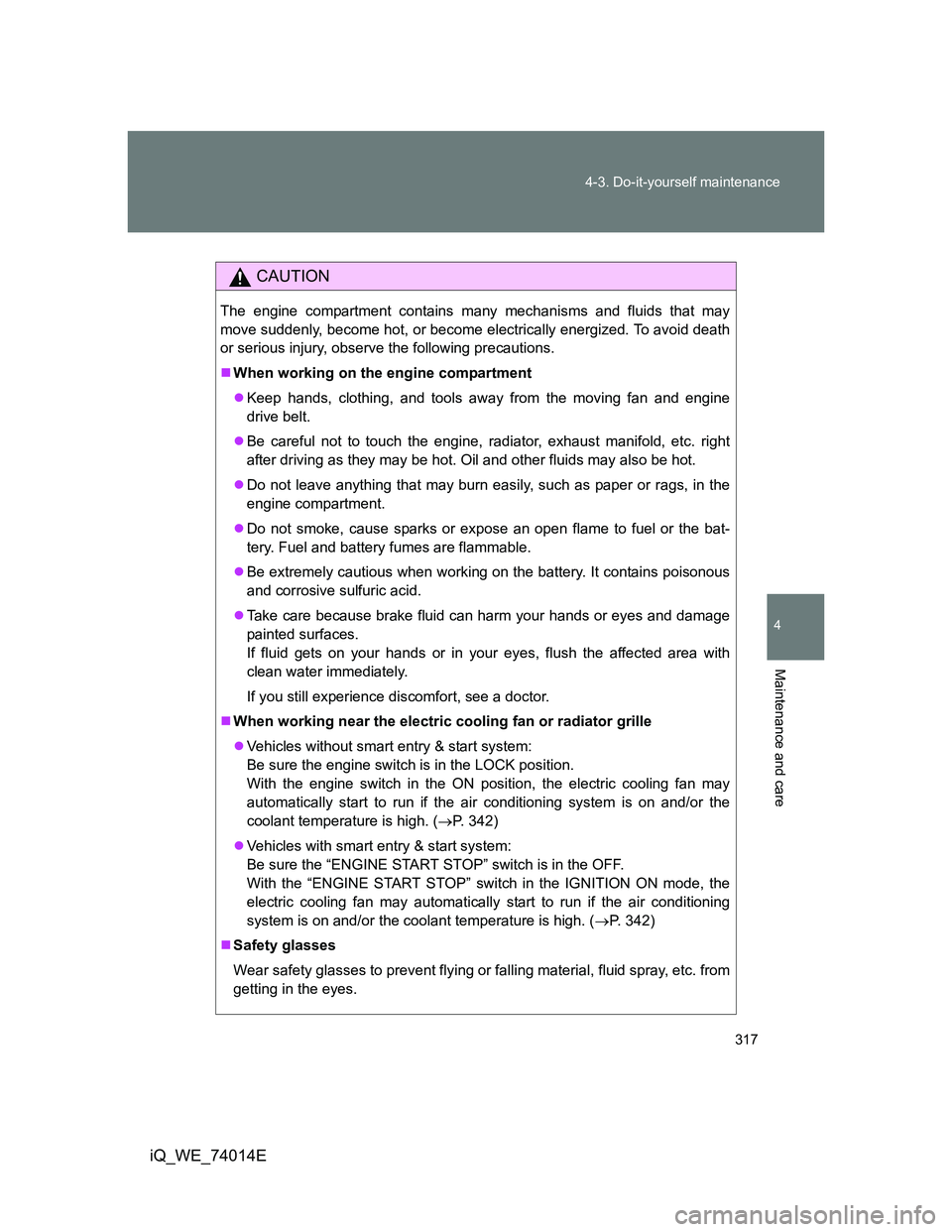
317 4-3. Do-it-yourself maintenance
4
Maintenance and care
iQ_WE_74014E
CAUTION
The engine compartment contains many mechanisms and fluids that may
move suddenly, become hot, or become electrically energized. To avoid death
or serious injury, observe the following precautions.
When working on the engine compartment
Keep hands, clothing, and tools away from the moving fan and engine
drive belt.
Be careful not to touch the engine, radiator, exhaust manifold, etc. right
after driving as they may be hot. Oil and other fluids may also be hot.
Do not leave anything that may burn easily, such as paper or rags, in the
engine compartment.
Do not smoke, cause sparks or expose an open flame to fuel or the bat-
tery. Fuel and battery fumes are flammable.
Be extremely cautious when working on the battery. It contains poisonous
and corrosive sulfuric acid.
Take care because brake fluid can harm your hands or eyes and damage
painted surfaces.
If fluid gets on your hands or in your eyes, flush the affected area with
clean water immediately.
If you still experience discomfort, see a doctor.
When working near the electric cooling fan or radiator grille
Vehicles without smart entry & start system:
Be sure the engine switch is in the LOCK position.
With the engine switch in the ON position, the electric cooling fan may
automatically start to run if the air conditioning system is on and/or the
coolant temperature is high. (P. 342)
Vehicles with smart entry & start system:
Be sure the “ENGINE START STOP” switch is in the OFF.
With the “ENGINE START STOP” switch in the IGNITION ON mode, the
electric cooling fan may automatically start to run if the air conditioning
system is on and/or the coolant temperature is high. (P. 342)
Safety glasses
Wear safety glasses to prevent flying or falling material, fluid spray, etc. from
getting in the eyes.
Page 350 of 476
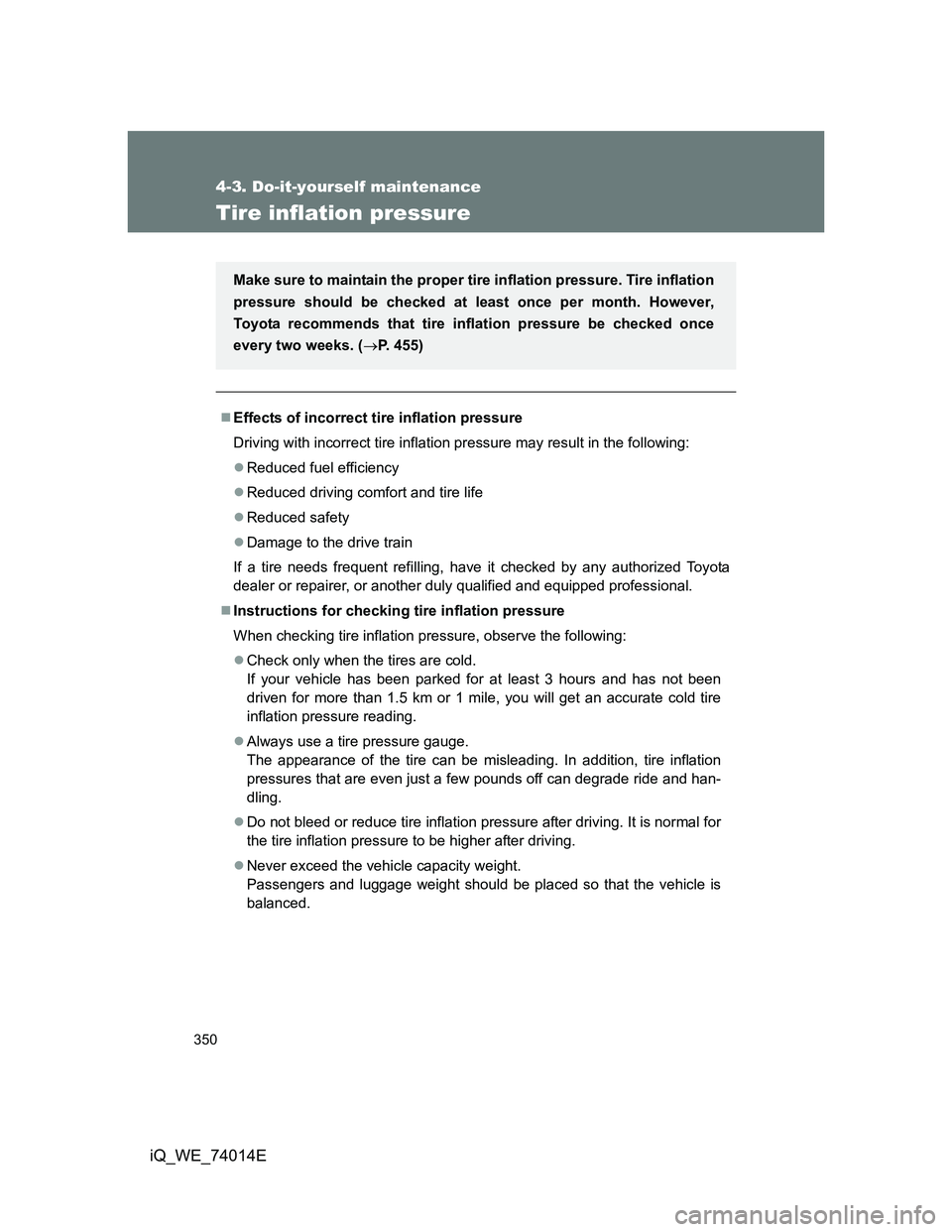
350
4-3. Do-it-yourself maintenance
iQ_WE_74014E
Tire inflation pressure
Effects of incorrect tire inflation pressure
Driving with incorrect tire inflation pressure may result in the following:
Reduced fuel efficiency
Reduced driving comfort and tire life
Reduced safety
Damage to the drive train
If a tire needs frequent refilling, have it checked by any authorized Toyota
dealer or repairer, or another duly qualified and equipped professional.
Instructions for checking tire inflation pressure
When checking tire inflation pressure, observe the following:
Check only when the tires are cold.
If your vehicle has been parked for at least 3 hours and has not been
driven for more than 1.5 km or 1 mile, you will get an accurate cold tire
inflation pressure reading.
Always use a tire pressure gauge.
The appearance of the tire can be misleading. In addition, tire inflation
pressures that are even just a few pounds off can degrade ride and han-
dling.
Do not bleed or reduce tire inflation pressure after driving. It is normal for
the tire inflation pressure to be higher after driving.
Never exceed the vehicle capacity weight.
Passengers and luggage weight should be placed so that the vehicle is
balanced.
Make sure to maintain the proper tire inflation pressure. Tire inflation
pressure should be checked at least once per month. However,
Toyota recommends that tire inflation pressure be checked once
every two weeks. (P. 455)
Page 368 of 476
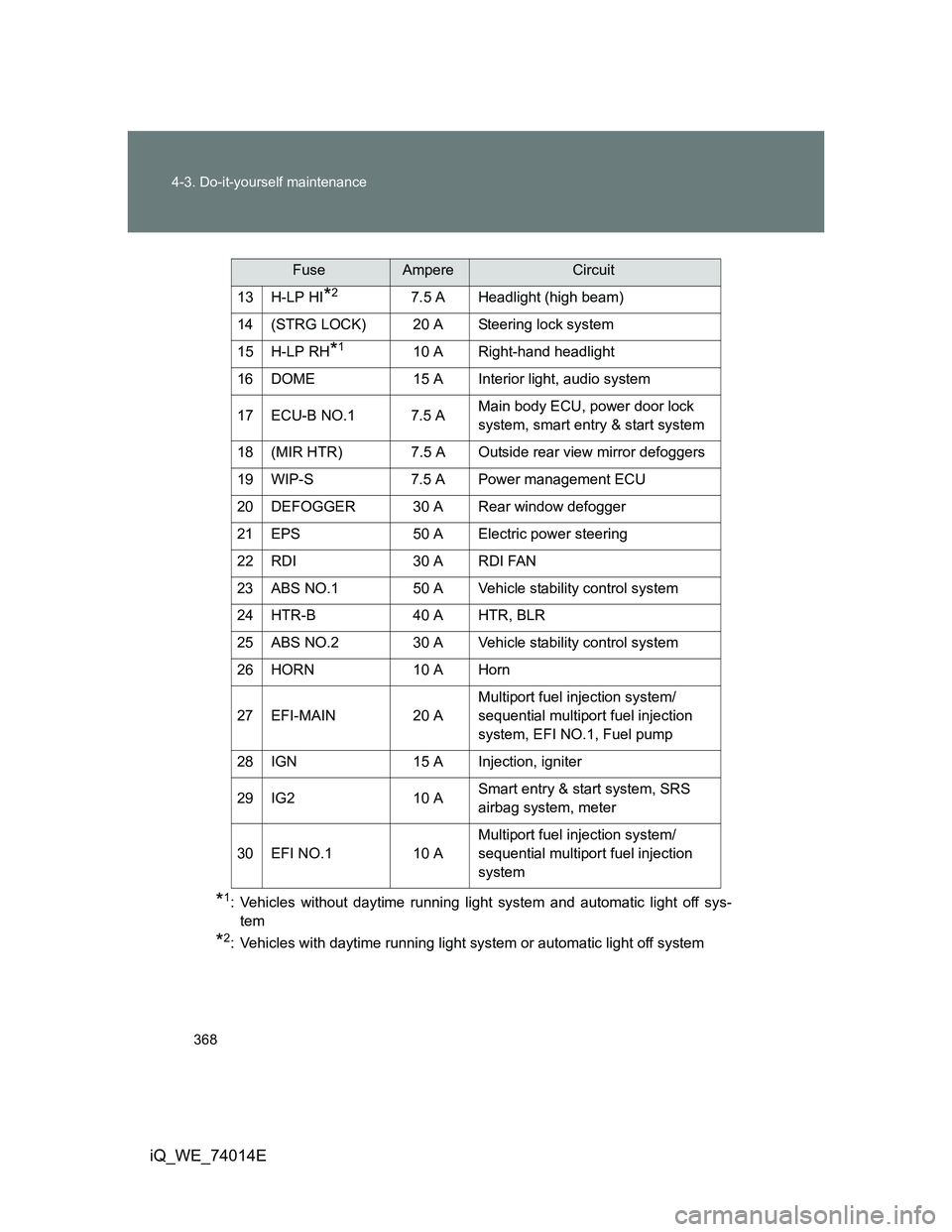
368 4-3. Do-it-yourself maintenance
iQ_WE_74014E
*1: Vehicles without daytime running light system and automatic light off sys-
tem
*2: Vehicles with daytime running light system or automatic light off system13 H-LP HI
*27.5 A Headlight (high beam)
14 (STRG LOCK) 20 A Steering lock system
15 H-LP RH
*110 A Right-hand headlight
16 DOME 15 A Interior light, audio system
17 ECU-B NO.1 7.5 AMain body ECU, power door lock
system, smart entry & start system
18 (MIR HTR) 7.5 A Outside rear view mirror defoggers
19 WIP-S 7.5 A Power management ECU
20 DEFOGGER 30 A Rear window defogger
21 EPS 50 A Electric power steering
22 RDI 30 A RDI FAN
23 ABS NO.1 50 A Vehicle stability control system
24 HTR-B 40 A HTR, BLR
25 ABS NO.2 30 A Vehicle stability control system
26 HORN 10 A Horn
27 EFI-MAIN 20 AMultiport fuel injection system/
sequential multiport fuel injection
system, EFI NO.1, Fuel pump
28 IGN 15 A Injection, igniter
29 IG2 10 ASmart entry & start system, SRS
airbag system, meter
30 EFI NO.1 10 AMultiport fuel injection system/
sequential multiport fuel injection
system
FuseAmpereCircuit
Page 370 of 476
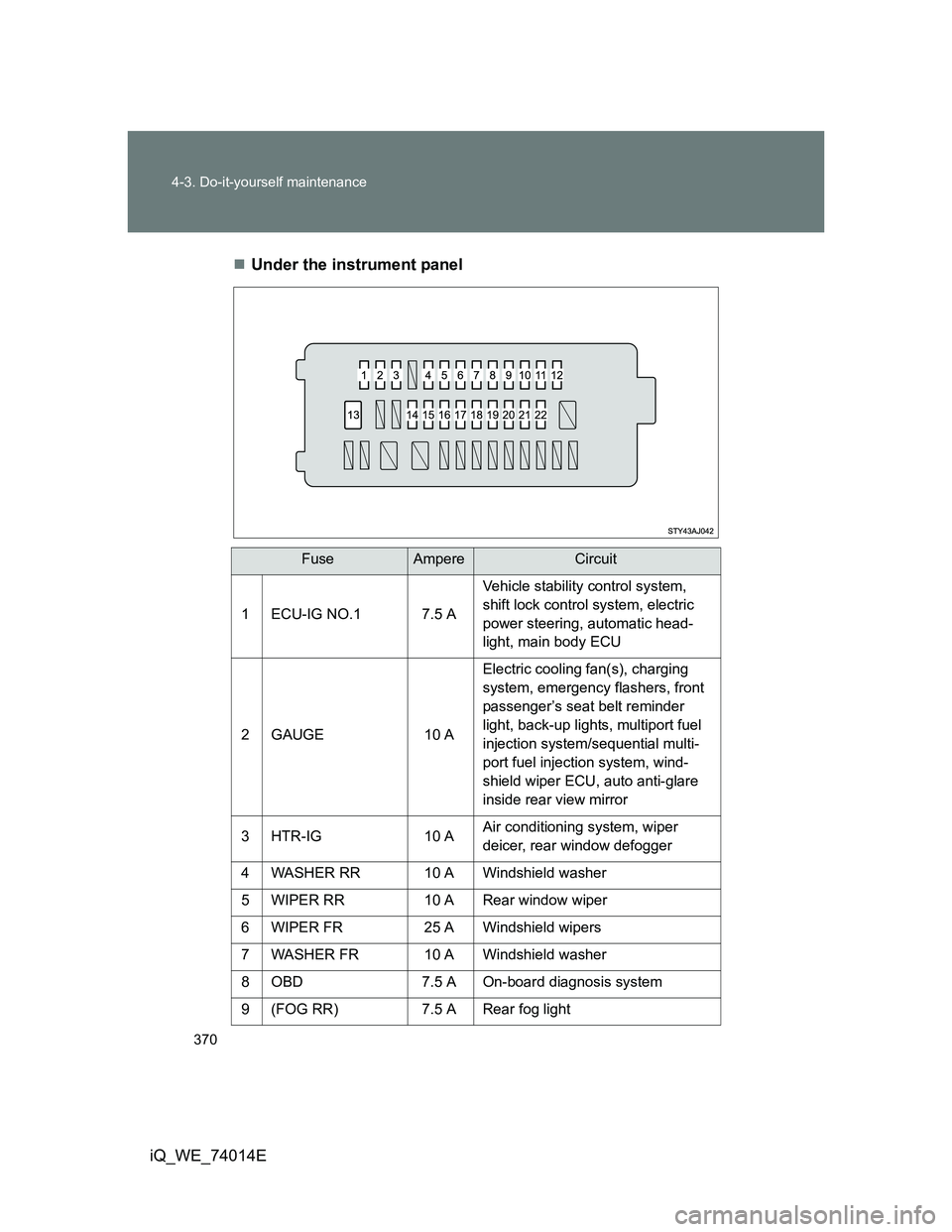
370 4-3. Do-it-yourself maintenance
iQ_WE_74014EUnder the instrument panel
FuseAmpereCircuit
1 ECU-IG NO.1 7.5 AVehicle stability control system,
shift lock control system, electric
power steering, automatic head-
light, main body ECU
2 GAUGE 10 AElectric cooling fan(s), charging
system, emergency flashers, front
passenger’s seat belt reminder
light, back-up lights, multiport fuel
injection system/sequential multi-
port fuel injection system, wind-
shield wiper ECU, auto anti-glare
inside rear view mirror
3 HTR-IG 10 AAir conditioning system, wiper
deicer, rear window defogger
4 WASHER RR 10 A Windshield washer
5 WIPER RR 10 A Rear window wiper
6 WIPER FR 25 A Windshield wipers
7 WASHER FR 10 A Windshield washer
8 OBD 7.5 A On-board diagnosis system
9 (FOG RR) 7.5 A Rear fog light
Page 371 of 476
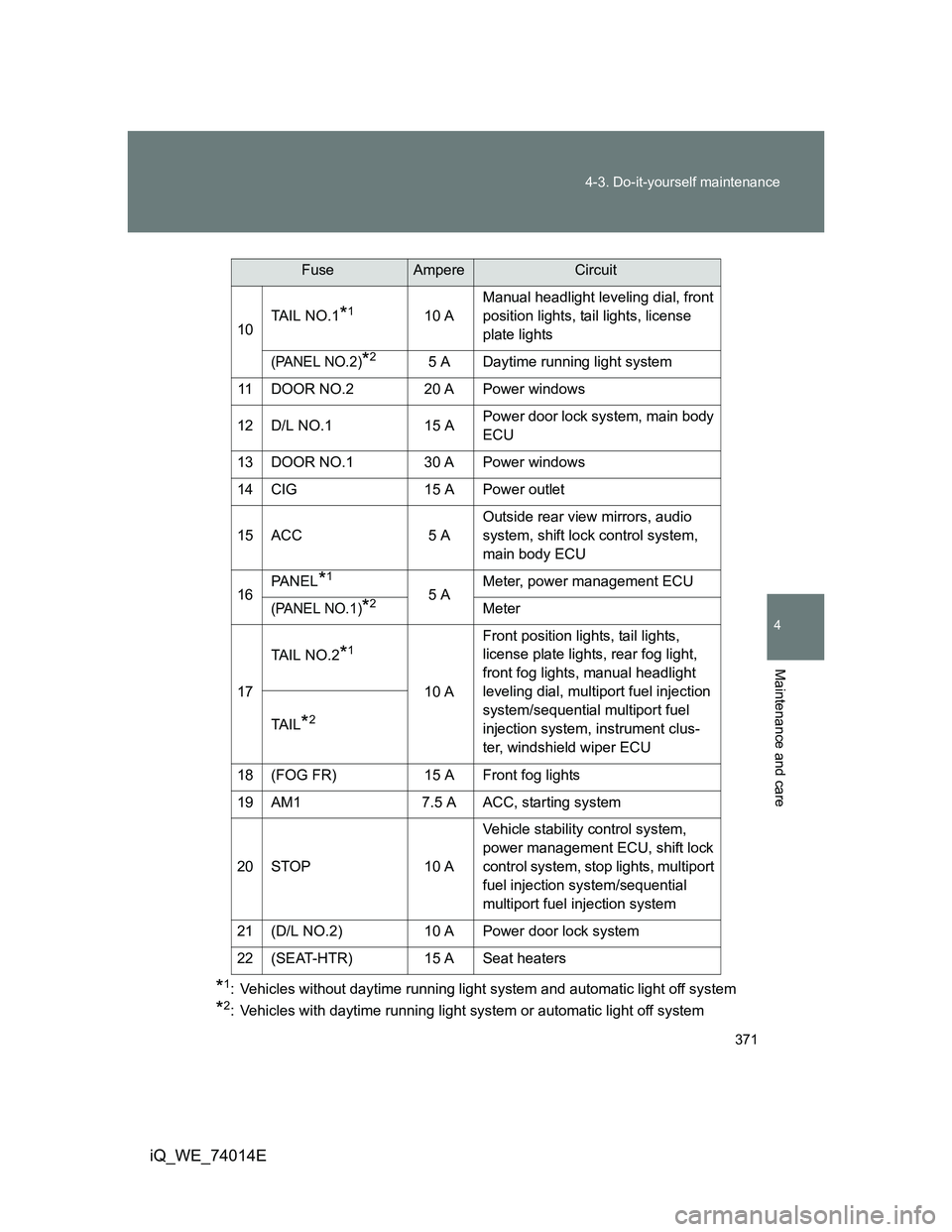
371 4-3. Do-it-yourself maintenance
4
Maintenance and care
iQ_WE_74014E
*1: Vehicles without daytime running light system and automatic light off system
*2: Vehicles with daytime running light system or automatic light off system10TAIL NO.1
*110 AManual headlight leveling dial, front
position lights, tail lights, license
plate lights
(PANEL NO.2)*25 A Daytime running light system
11 DOOR NO.2 20 A Power windows
12 D/L NO.1 15 APower door lock system, main body
ECU
13 DOOR NO.1 30 A Power windows
14 CIG 15 A Power outlet
15 ACC 5 AOutside rear view mirrors, audio
system, shift lock control system,
main body ECU
16PA N E L
*1
5 AMeter, power management ECU(PANEL NO.1)*2Meter
17TAIL NO.2
*1
10 AFront position lights, tail lights,
license plate lights, rear fog light,
front fog lights, manual headlight
leveling dial, multiport fuel injection
system/sequential multiport fuel
injection system, instrument clus-
ter, windshield wiper ECU TA I L
*2
18 (FOG FR) 15 A Front fog lights
19 AM1 7.5 A ACC, starting system
20 STOP 10 AVehicle stability control system,
power management ECU, shift lock
control system, stop lights, multiport
fuel injection system/sequential
multiport fuel injection system
21 (D/L NO.2) 10 A Power door lock system
22 (SEAT-HTR) 15 A Seat heaters
FuseAmpereCircuit
Page 385 of 476
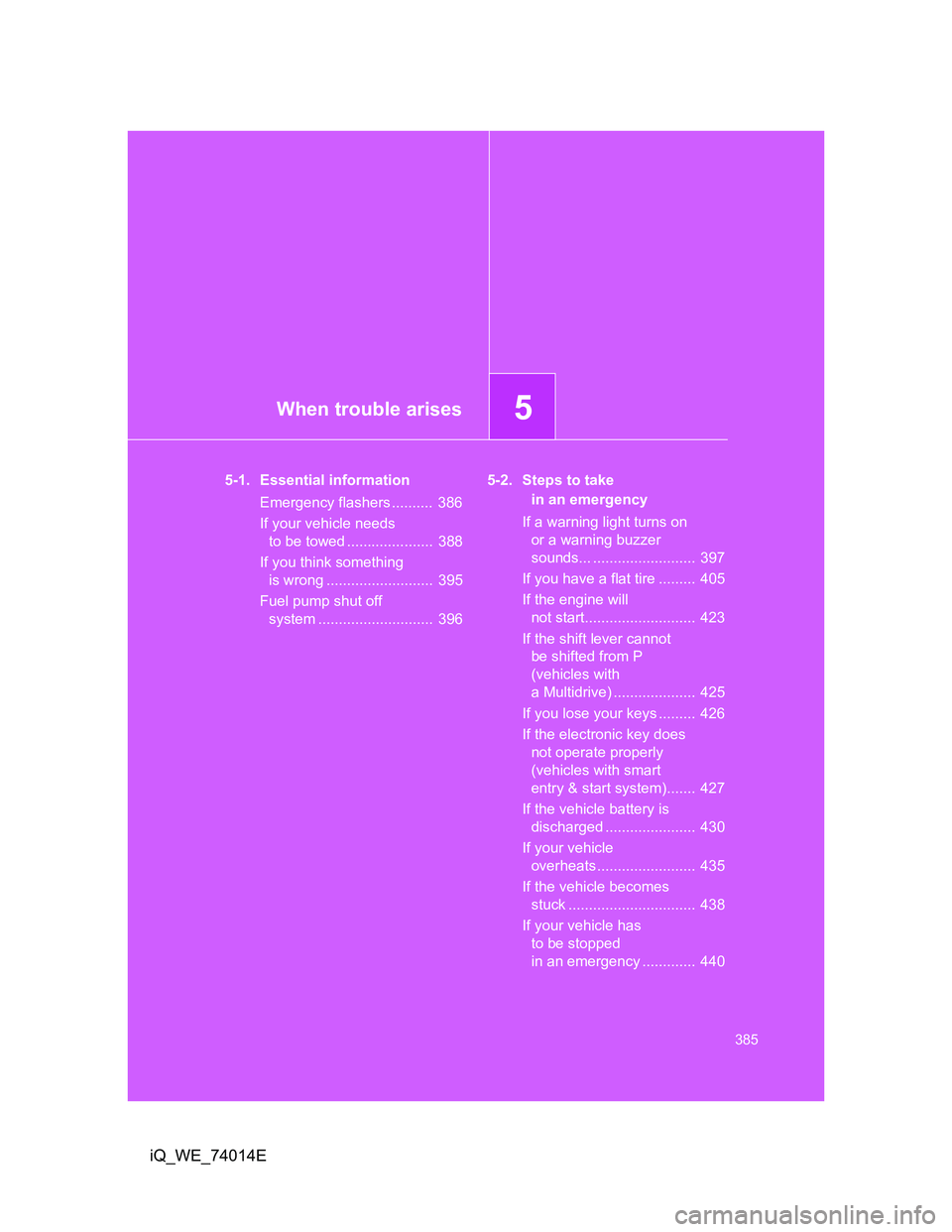
5When trouble arises
385
iQ_WE_74014E
5-1. Essential information
Emergency flashers .......... 386
If your vehicle needs
to be towed ..................... 388
If you think something
is wrong .......................... 395
Fuel pump shut off
system ............................ 3965-2. Steps to take
in an emergency
If a warning light turns on
or a warning buzzer
sounds... ......................... 397
If you have a flat tire ......... 405
If the engine will
not start........................... 423
If the shift lever cannot
be shifted from P
(vehicles with
a Multidrive) .................... 425
If you lose your keys ......... 426
If the electronic key does
not operate properly
(vehicles with smart
entry & start system)....... 427
If the vehicle battery is
discharged ...................... 430
If your vehicle
overheats ........................ 435
If the vehicle becomes
stuck ............................... 438
If your vehicle has
to be stopped
in an emergency ............. 440
Page 396 of 476
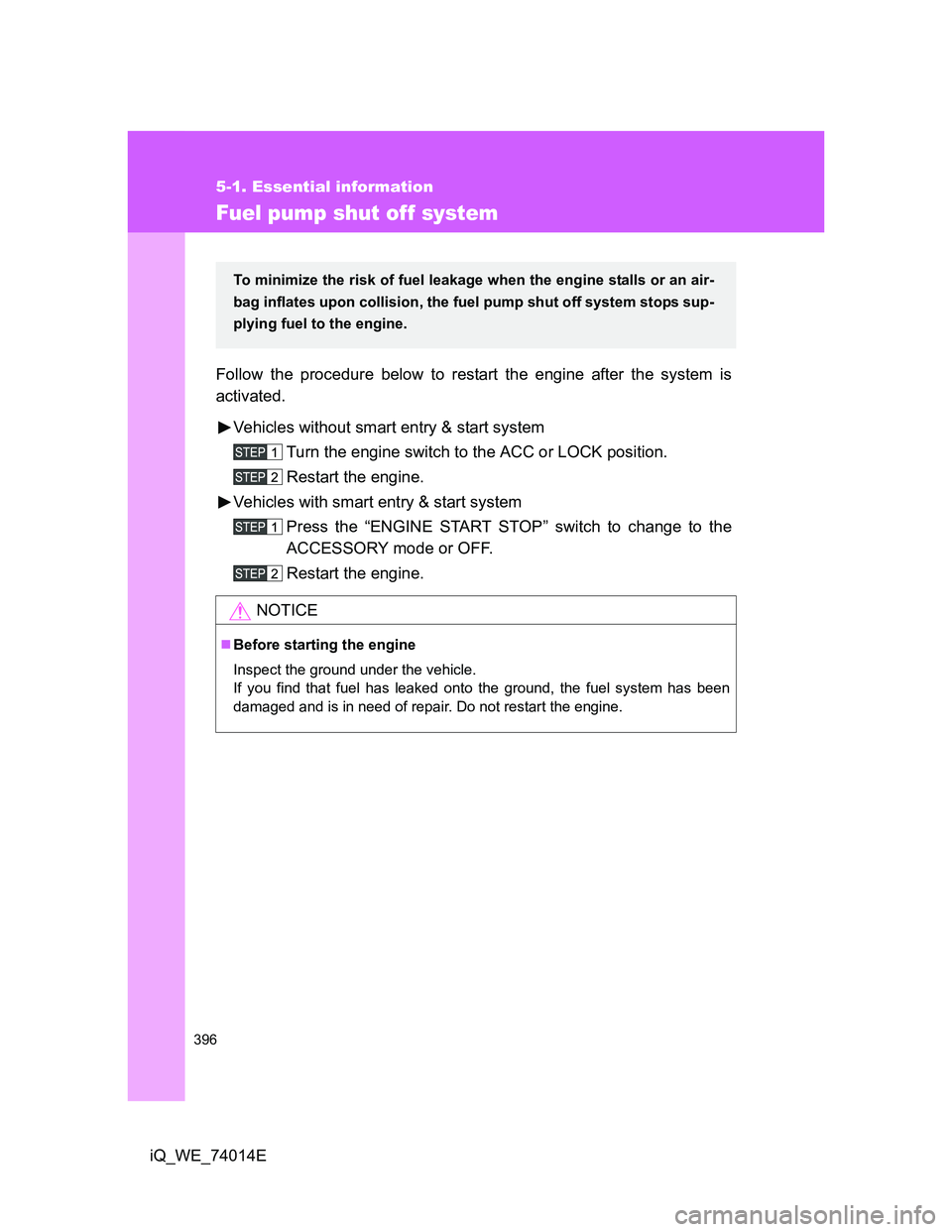
396
5-1. Essential information
iQ_WE_74014E
Fuel pump shut off system
Follow the procedure below to restart the engine after the system is
activated.
Vehicles without smart entry & start system
Turn the engine switch to the ACC or LOCK position.
Restart the engine.
Vehicles with smart entry & start system
Press the “ENGINE START STOP” switch to change to the
ACCESSORY mode or OFF.
Restart the engine.
NOTICE
Before starting the engine
Inspect the ground under the vehicle.
If you find that fuel has leaked onto the ground, the fuel system has been
damaged and is in need of repair. Do not restart the engine.
To minimize the risk of fuel leakage when the engine stalls or an air-
bag inflates upon collision, the fuel pump shut off system stops sup-
plying fuel to the engine.
Page 399 of 476
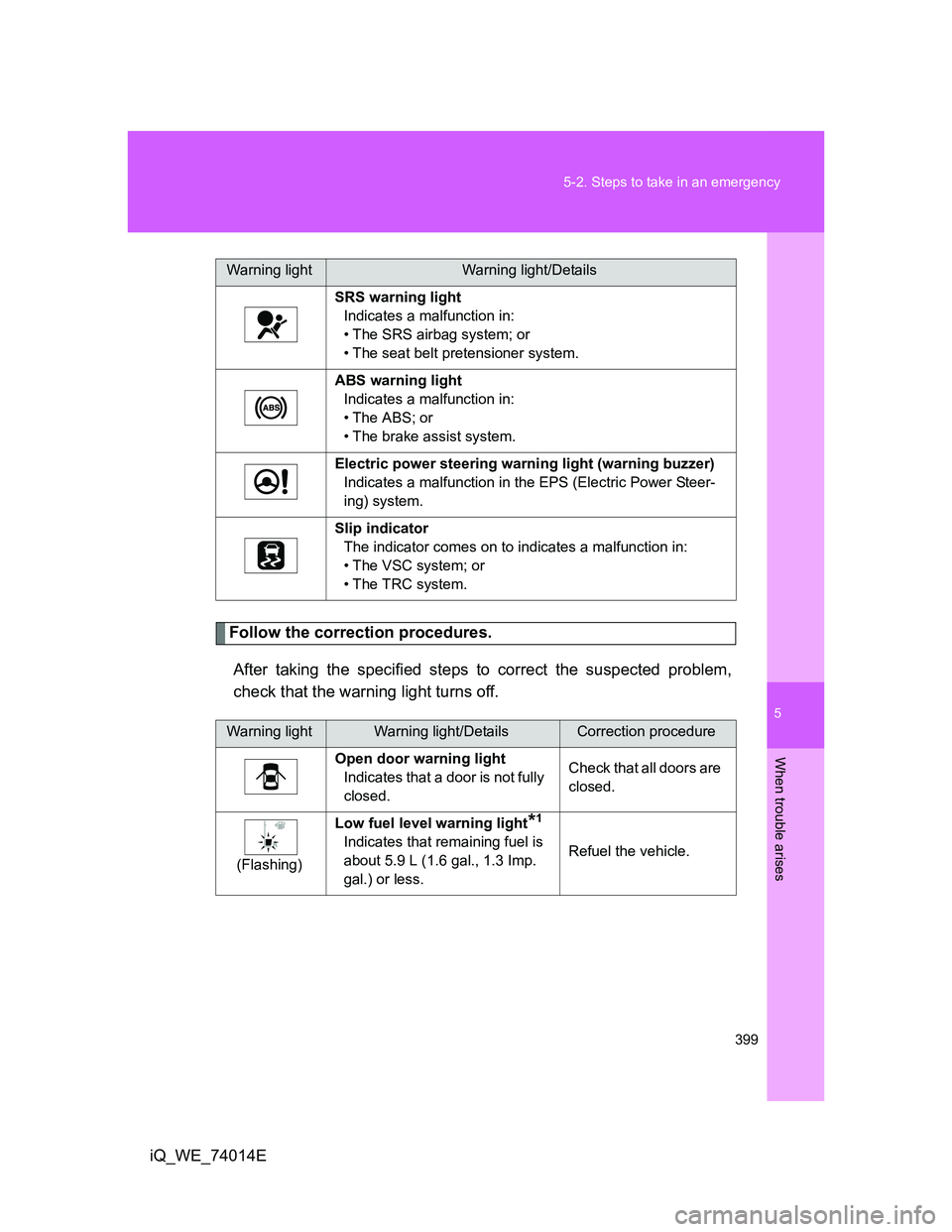
5
399 5-2. Steps to take in an emergency
When trouble arises
iQ_WE_74014E
Follow the correction procedures.
After taking the specified steps to correct the suspected problem,
check that the warning light turns off.
SRS warning light
Indicates a malfunction in:
• The SRS airbag system; or
• The seat belt pretensioner system.
ABS warning light
Indicates a malfunction in:
• The ABS; or
• The brake assist system.
Electric power steering warning light (warning buzzer)
Indicates a malfunction in the EPS (Electric Power Steer-
ing) system.
Slip indicator
The indicator comes on to indicates a malfunction in:
• The VSC system; or
• The TRC system.
Warning lightWarning light/DetailsCorrection procedure
Open door warning light
Indicates that a door is not fully
closed.Check that all doors are
closed.
(Flashing)Low fuel level warning light
*1
Indicates that remaining fuel is
about 5.9 L (1.6 gal., 1.3 Imp.
gal.) or less.Refuel the vehicle.
Warning lightWarning light/Details